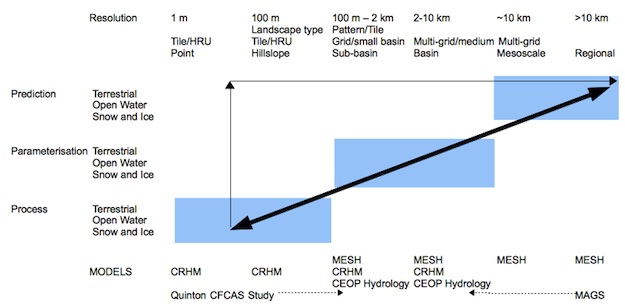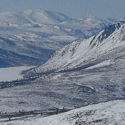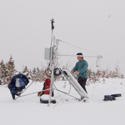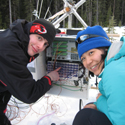|
Theme
2 - Parameterisation
Theme Lead: Bill Quinton,
Wilfrid Laurier University
(e-mail; www)
The objective of Theme 2 is to integrate the
individual natural processes identified and described in Theme 1, improving the basin-scale parameterisation of the cold regions hydrological
processes which control the coupled atmospheric-hydrological system.
Processes associated with surface hydrology work in different ways on landscapes with different
biogeoclimatic characteristics; forests, tundra, wetlands, and lakes all require distinctive strategies that
describe the unique water and energy flow in each ecosystem.
The IP3 strategy is to focus initially on describing processes within
Hydrological Response Units (HRUs), small drainage units which possess
essentially homegenous conditions and characteristics, but with allowances for
subtle variability; examples might be a section of hillside, a forest stand, or
a wetland area.
The HRU is treated as a control volume for mass and energy budgeting, and is represented by
average state variables for the unit as a whole.
Observations of exchanges between HRUs enable descriptions to be
derived of the amalgamation of their individual responses into those of
sub-basins (small catchments), and from there to basin-groups
(larger watersheds).
By evaluating these models against observations made in the wide variety of
natural contexts found in the IP3 research basins, parameterisations have been developed which are transferable from the point
scale (at which observations are made), to small and large basins (at which
predictions are required).

The principal modelling tool being used in IP3 to develop and test new process algorithms
and parameterisations is the Cold Regions Hydrological Model
(CRHM). CRHM is being developed by IP3 as a framework for the
representation of algorithms based on physical hydrological processes, and their integration into more complex models
of natural systems at a range of resolutions.
CRHM is thus being used to develop and test IP3's mathematical descriptions of the natural world; it provides a
flexible and powerful proving ground, where parameterisations may be tested
alone and then together with others, in order to demonstrate - by evaluation
against natural data gathered from IP3's research basins - whether or not the
process-descriptions are complete, and may be applied to various permutations
and combinations of environmental conditions and characteristics.
Once parameterisations have been evaluated successfully in CRHM, they are
incorporated into IP3's strategic coupled hydrological-atmospheric model, MESH,
described in Theme 3.
Theme 2 Timeline:
2007
- Setup CRHM at selected test basins representing each of the 4 regions
(i.e. arctic, alpine, wetland, shield) in HRU and then GRU mode
- Assess existing parameterizations against archives of mass and energy
balances over complex terrain
- Initial development of improved parameterizations including advection
- Coordinate with the WC2N (CFCAS Network) group to acquire data set for
testing mass and energy balance models over glaciated terrain
- Assessment of MAGS aircraft for use in determining regionally averaged
fluxes
2008
- Performance evaluation of CRHM in both GRU and HRU routing/aggregation
modes against field and distributed modelling data
- Evaluate MESH performance with reference to measured mass and energy
balances, CRHM and distributed modelling data
- Characterize surface parameter distributions
- Develop improved snow, melt, subsurface flow, radiation and turbulent flux
parameterizations
2009
- Incorporate numerical representations of snow redistribution, advection,
lakes, landscape and water course connectivity, into CRHM and MESH
- Develop up-scaled mass and energy balance equations for cryospheric
processes in complex vegetated terrain
- representation of regionally averaged fluxes over lake and snow dominated
terrain
2010
- Test and evaluate CRHM and MESH (CLASS) with new algorithms, and compare
model outputs to observations, distributed models and output of previous
version. Revise code
- Compare CRCM runs to observations, revise CLASS code as necessary
- Implement parameterizations in coupled models
|
Participants |
|
|
Sean Carey |
Carleton University |
|
Richard Essery |
University of Edinburgh, UK |
|
Raoul Granger |
Environment Canada |
|
Masaki Hayashi |
University of Calgary |
|
Murray Mackay |
Environment Canada |
|
Philip Marsh |
University of Saskatchewan |
|
Scott Munro |
University of Toronto |
|
John Pomeroy |
University of Saskatchewan |
|
William Quinton |
Wilfrid Laurier University |
|
Ken Snelgrove |
Memorial University of Newfoundland |
|
Ric Soulis |
University of Waterloo |
|
Chris Spence |
University of Saskatchewan |
|
Diana Verseghy |
University of Waterloo |
|
















